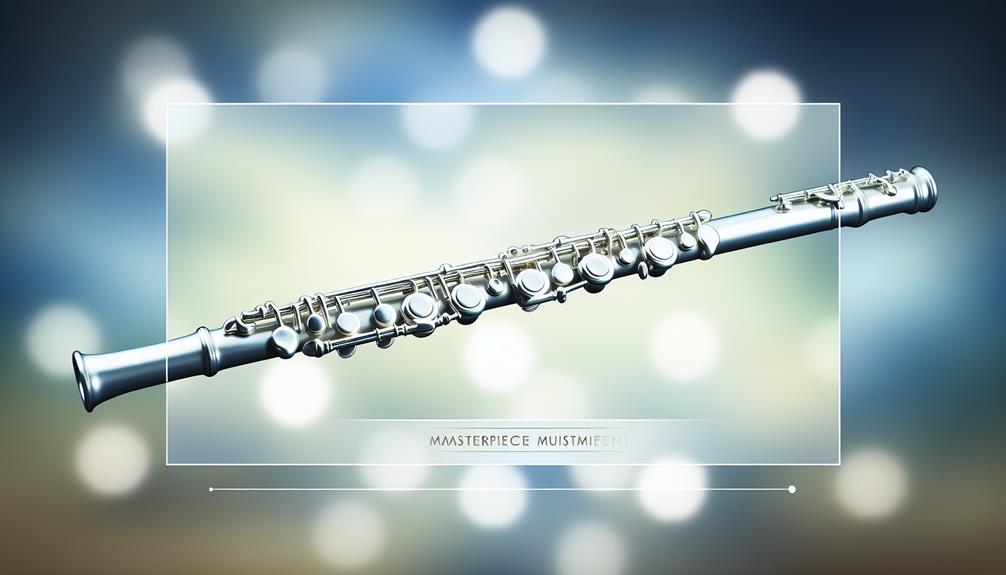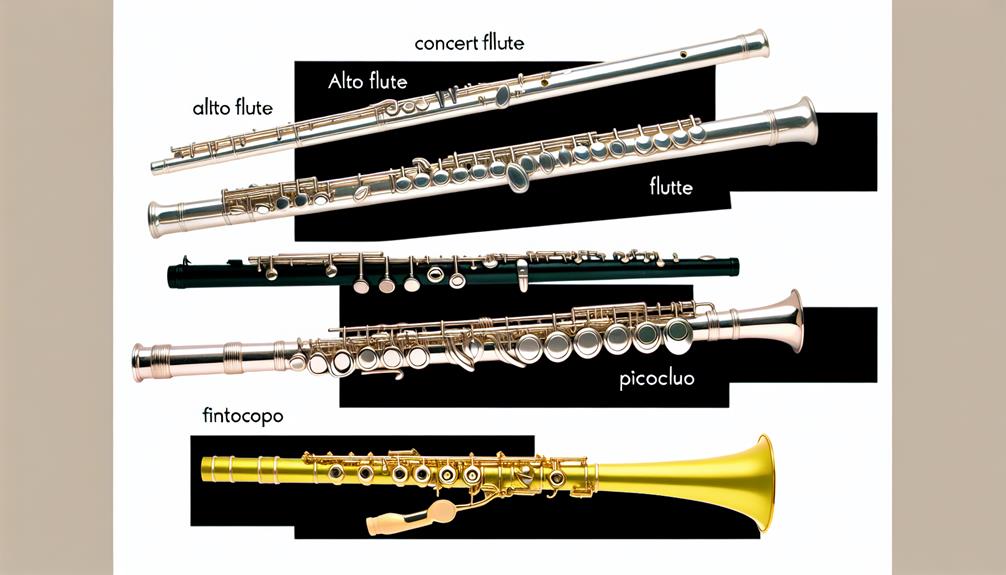When considering the question of whether playing the flute is easy, one must first acknowledge the instrument's rich history and the technical skill it demands.
The physical requirements, intricate fingerings, and nuances of breath control all contribute to the complexity of mastering the flute. While some may find initial progress gratifying, there are common challenges that often arise for beginners.
However, with diligent practice and guidance, navigating these obstacles can lead to a rewarding musical journey.
Understanding how to overcome these hurdles and refine one's technique is key to unlocking the flute's true potential.
Key Takeaways
- Mastering the flute requires dedication to breath control, finger dexterity, and precise techniques.
- Beginners face challenges with embouchure, finger coordination, and breath management.
- Proper posture, practice, and technique refinement are essential for progressing in flute playing.
- Enhancing flute skills involves deep breathing, good posture, regular practice, and focused skill development.
History of the Flute
What historical developments led to the creation of the flute as we know it today?
The history of the flute dates back thousands of years, with evidence of early flutes found in various ancient civilizations such as Egypt, Greece, and Rome. One of the key developments in the evolution of the flute was the addition of keys to the instrument in the 19th century, which allowed for more complex music to be played.
The modern flute, known as the Western concert flute, was perfected in the 19th century by Theobald Boehm, a German flutist and inventor. Boehm's design innovations, including the use of metal instead of wood and a new system of keys, revolutionized the instrument, making it more reliable and easier to play. These developments paved the way for the flute as we recognize it today, with its sleek design and versatile range.
Understanding the historical journey of the flute helps us appreciate the instrument's rich heritage and the craftsmanship that has gone into shaping it into the elegant and expressive instrument it is today.
Physical Demands of Playing
The mastery of playing the flute requires a combination of physical dexterity, breath control, and precise hand movements. To excel in playing this beautiful instrument, musicians must be attuned to the physical demands it entails:
- Breath Control: Playing the flute demands strong breath support to produce clear and resonant tones. Musicians need to control their airflow to create the desired dynamics and articulations.
- Finger Dexterity: Swift and precise finger movements are essential for navigating the flute's keys. Coordination between the fingers is crucial for playing scales, arpeggios, and complex passages accurately.
- Posture and Body Alignment: Maintaining good posture while playing the flute is vital for breath control and sound production. Proper body alignment ensures that air is directed efficiently into the instrument, resulting in a rich and consistent tone.
These physical demands require dedication and practice to master, but the rewards of creating beautiful music make the journey worthwhile for those seeking to belong in the world of flute playing.
Learning Curve and Technique
Mastering the flute requires a meticulous approach to learning curve and technique, encompassing a blend of musical precision and technical finesse. Developing a solid foundation in flute playing involves mastering essential techniques such as proper embouchure, breath control, finger placement, and articulation. Progressing through the learning curve requires dedication, practice, and guidance from experienced instructors.
To give you a clearer picture of the techniques involved in mastering the flute, below is a table outlining some fundamental aspects:
| Technique | Description | Importance |
|---|---|---|
| Embouchure | Positioning and shaping of the lips | Crucial for tone quality and pitch accuracy |
| Breath Control | Regulating airflow and pressure | Essential for sustaining notes and dynamics |
| Finger Placement | Precise placement on keys and holes | Determines pitch and facilitates fluidity |
Common Challenges for Beginners
Navigating the initial stages of learning the flute presents beginners with various common challenges that require focused attention and practice to overcome. As aspiring flutists embark on their musical journey, they often encounter the following hurdles:
- Embouchure Development: Forming the correct embouchure, the positioning of the lips, and the control of air flow can be challenging initially. It takes time and practice to develop the muscle memory and coordination required for a consistent and clear sound.
- Finger Dexterity: Coordinating finger movements to cover the tone holes accurately while maintaining proper posture and hand position can be daunting for beginners. Developing agility and precision in finger placement is crucial for playing melodies smoothly.
- Breath Control: Controlling breath support to produce a steady sound, navigate through different dynamics, and execute phrases seamlessly poses a common challenge. Beginners often struggle with breath management and learning how to breathe deeply and efficiently while playing.
Overcoming these challenges demands patience, perseverance, and dedicated practice to progress and eventually master the art of playing the flute.
Tips for Making Flute Playing Easier
To enhance the ease of playing the flute, incorporating proper breathing techniques is essential for achieving a smoother and more controlled sound production. Proper breath support involves taking deep breaths from the diaphragm rather than shallow chest breaths. This technique allows for consistent airflow, which is crucial for producing clear and resonant tones on the flute. Additionally, maintaining good posture while playing is key to optimizing airflow and reducing physical strain. Keeping the body relaxed and aligned helps in producing a more effortless sound.
Another tip for making flute playing easier is to practice regularly and consistently. Dedicate time each day to work on scales, exercises, and pieces to build muscle memory and improve overall proficiency. Breaking down challenging passages into smaller sections and practicing them slowly can also aid in mastering difficult parts more efficiently.
Furthermore, staying hydrated and taking care of the flute by keeping it clean and well-maintained can contribute to a smoother playing experience. Regular maintenance ensures that the instrument functions properly, allowing for easier production of sound. By implementing these tips, flute players can enhance their playing experience and make the journey of learning the flute more enjoyable and rewarding.
Frequently Asked Questions
Are There Any Health Benefits Associated With Playing the Flute?
Playing the flute offers numerous health benefits, including improved lung capacity, enhanced respiratory function, and increased hand-eye coordination. Additionally, it can serve as a form of relaxation and stress relief, promoting overall well-being and mental health.
What Are Some Common Misconceptions About Learning to Play the Flute?
Common misconceptions about learning to play the flute include it being only for the musically gifted, requiring natural talent, and being too challenging. In reality, with dedication, practice, and guidance, anyone can learn to play the flute proficiently.
Can Playing the Flute Help Improve Cognitive Abilities or Focus?
Playing the flute can enhance cognitive abilities and focus. Research suggests that learning an instrument can improve memory, concentration, and problem-solving skills. The intricate coordination required for flute playing can strengthen neural connections and foster mental acuity.
Are There Different Types of Flutes and How Do They Differ in Difficulty to Play?
There are various types of flutes, such as the concert flute, piccolo, and alto flute. These differ in size, pitch range, and technique required to play them. Each flute presents unique challenges, offering diverse musical experiences for players to explore.
How Important Is It to Have a Good Teacher When Learning to Play the Flute?
Having a good teacher when learning to play the flute is crucial for proper technique, musicality, and progress. A skilled instructor can provide guidance, feedback, and personalized instruction that significantly enhances a student's learning experience and development.
Conclusion
In conclusion, playing the flute requires dedication and practice to master. Despite its challenges, the flute offers a beautiful and rewarding musical experience for those who persevere.
By understanding the history, physical demands, learning curve, and common challenges of playing the flute, individuals can improve their technique and make the process easier.
With the right mindset and commitment, anyone can learn to play the flute and enjoy the art of music-making.





